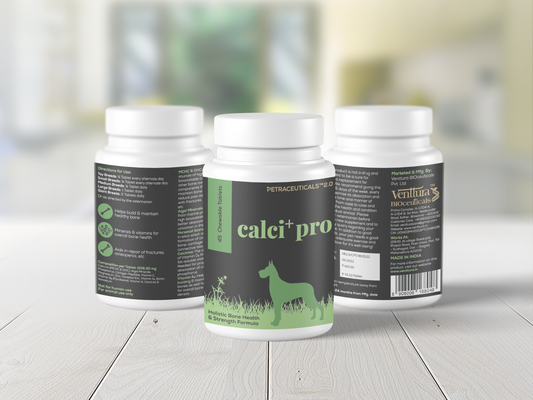Introduction
The liver plays a key role in metabolism, detoxification, and regulating inflammation and cell regeneration. When exposed to harmful substances beyond its repair capacity, liver diseases (both acute and chronic) often involve inflammation. Hepatocytes and other liver cells activate enzymatic and non-enzymatic defence mechanisms to neutralize toxins from drugs, chemicals, and xenobiotics. In liver disease, mitochondria and the endoplasmic reticulum produce reactive oxygen species (ROS). Normally, antioxidant systems protect cells from ROS, but excessive production overwhelms these defences, leading to cell damage. Phytotherapy, the use of plant-based compounds for medicinal purposes, is gaining attention for treating liver diseases in dogs. There is increasing interest in the antioxidant and liver-protective properties of various plants. It is considered a safe and gentle alternative to conventional medicine since it comes from natural sources [1]. This article focuses on silymarin, a plant-derived compound recognized for its liver-supportive properties, and examines its potential benefits in the management of liver health in dogs. The article will discuss how silymarin works and its benefits for liver health and overall well-being in pets.
Overview of Silymarin
Silybum marianum, commonly known as milk thistle, is a biennial plant from the Asteraceae family, naturally growing in parts of southern and central Europe. Its primary active ingredient is silymarin, a phytocomplex rich in flavonoids. The most significant among these flavonoids are silybin, isosilybin, silychristin, and silydianin, which are mainly found in the plant’s fruits and seeds [2]. Silybum marianum encompasses daisies and thistles, including the common thistle and artichoke. The plant itself, with large purple flowering heads, grows as a stout thistle in rocky soils. The leaves are characterized by milky veins from which the plant derives its name. It is one of the oldest and most thoroughly researched plants in the treatment of the liver diseases. The active extract of milk thistle is a mixture of the flavonolignans, containing approximately 70-80% of the silymarin and 20-30% of a chemically undefined fraction, comprising polymeric and oxidized polyphenolic fraction (PP) [3]. Preclinical studies using various hepatotoxic substances have demonstrated that silymarin acts as a hepatoprotective agent through multiple mechanisms. Its most significant effects include antioxidant properties and cell regeneration by enhancing protein synthesis [4] [5]. Silymarin’s protective actions are based on four key mechanisms:
· Preventing lipid peroxidation by scavenging free radicals and increasing cellular glutathione levels.
· Regulating membrane permeability and enhancing membrane stability against xenobiotic damage.
· Modulating nuclear expression through a steroid-like effect.
· Inhibiting the transformation of stellate hepatocytes into myofibroblasts, which contribute to collagen deposition and cirrhosis [3].
Benefits of Silymarin
Antioxidant for Liver Health
Silymarin’s protective effects come mainly from its antioxidant and free radical scavenging properties[6]. Free radicals like superoxide, hydroxyl radicals, hydrogen peroxide, and lipid peroxide radicals contribute to liver diseases. These reactive oxygen species (ROS) form naturally in the body through biochemical processes and increase with exposure to toxins. ROS damage cells by triggering lipid peroxidation in the cell membrane, leading to a chain reaction that further oxidizes membrane lipids and proteins [3]. The primary antioxidant action of silymarin lies in its capacity to inhibit enzymes responsible for ROS production, thereby preventing free radical generation [7]. Its therapeutic efficacy is largely attributed to its role in lowering liver enzyme activity [1] [7]. Silymarin helps counteract this damage by protecting two key detoxifying mechanisms—glutathione (GSH) and superoxide dismutase (SOD). It reduces free radical buildup, boosts GSH levels, and enhances SOD activity. Without this protection, vital cell components like DNA and RNA become vulnerable to damage [8]. In a study, researchers looked at the effect of adding several plant-based supplements to the diet of 74 dogs. They found that when dogs were given 10 mg of silymarin per kg of body weight each day, dogs that had higher ALT and GTP levels on the first day of the study showed a reduction in these levels after 60 days. Additionally, the researchers observed an increase in two factors: plasma paraoxonase (PON), an enzyme that helps protect against oxidative damage, and a gene responsible for mitochondrial superoxide dismutase 2 (SOD2), which helps prevent cell damage. These results support the idea that silymarin has antioxidant effects [9].
Fibrosis Prevention
Fibrosis can cause structural changes, leading to liver failure, high blood pressure in the portal vein, and brain-related complications. This process involves various cells and signaling molecules [10]. Initially, liver cells multiply, and hepatic stellate cells (HSCs) transform into myofibroblasts, a key event in fibrosis. Silymarin helps counteract fibrosis by inhibiting HSC activation, which in turn limits the excessive production of fibrosis-promoting factors. Kupffer cells, which activate HSCs, play a major role in fibrosis. Silymarin helps by blocking their production of harmful substances like reactive oxygen species and leukotrienes. Additionally, silymarin inhibits NF-κB, slowing HSC activation, and interferes with various protein kinases and signaling pathways that drive fibrosis [3] [10]. Silybin aids in preventing liver scarring by inhibiting the activation of stellate cells, which are responsible for excessive collagen production. Additionally, it enhances an enzyme that helps break down excess scar tissue. A study demonstrated that administering silybin at a dose of 50 mg/kg/day for six weeks reduced collagen accumulation in an inflamed liver by 12% and promoted the excretion of bile containing ursodeoxycholic acid [11].
Protection Against Drug and Toxin-Induced Liver Damage
Silymarin protects the liver from the deadly toxin α-amanitin found in Amanita phalloides (poisonous mushroom) by blocking its entry into liver cells. It does this by competing for the same transport system, preventing the toxin from inhibiting RNA polymerase II and stopping protein synthesis [3] [12]. Silymarin also helps stabilize liver and mitochondrial membranes, making them more resistant to damage from harmful substances[3]. By preventing toxin absorption and blocking transport proteins at the cell membrane, it further protects liver cells [12]. These protective effects, along with its antioxidant properties, make silymarin useful for treating liver damage caused by toxins and medications [3]. Liver intoxication from substances like paracetamol, ethanol, or phenylhydrazine accelerates cell respiration and releases toxic compounds called thiobarbituric acid reactive substances (TBARS). In response to oxidative stress, the glutathione (GSH) pool is depleted. However, rats treated with silybin (50 mg/kg) showed a significant reduction in oxygen consumption rate and stabilized GSH levels. This demonstrates that silybin not only reduces free radicals but also influences processes involving glutathione and superoxide dismutase. Additionally, it inhibits lipoxygenase, limiting lipid peroxidation [13]. A study found that supplementing dogs with a combination of SAMe and silybin led to a notable decrease in the activity of hepatic enzymes, such as ALT and ALP, during endotoxemia induced by LPS [14]. A study also reported that silymarin effectively protected against stanozolol-induced liver toxicity in a 2.5-year-old Doberman. The dog showed severe clinical symptoms and elevated liver enzymes after receiving a high dose of stanozolol. Treatment with a single dose of silymarin (30 mg/kg), along with supportive care, led to a rapid recovery, with enzyme levels returning to normal within 24 hours. This suggests that oral silymarin may help prevent liver toxicity caused by stanozolol in dogs, highlighting its potential in managing drug-induced liver damage [15].
Liver Protection and Regeneration
A study evaluated the regenerative effects of silymarin in dogs with hepatitis, showing significant improvement in liver function. Twelve dogs were divided into two groups, both receiving standard treatment, but one also received oral silymarin (16 mg/kg p.o bid) for seven days. While liver enzyme levels (ALT, SAP, γ-GT) remained unchanged in the non-silymarin group, dogs treated with silymarin showed a steady decline in these markers, indicating faster liver regeneration. Clinical improvement was also observed, with significant enzyme reductions by day seven. These findings support the use of silymarin as an effective supplement for managing liver disorders in dogs, aligning with human studies demonstrating its hepatoprotective benefits [16].
Support in Sepsis and Organ Protection
Sepsis is a severe and life-threatening condition characterized by a systemic inflammatory response to infection, most commonly caused by bacterial pathogens. The inflammatory cascade in sepsis can lead to widespread tissue damage, including damage to vital organs such as the heart, liver, and red blood cells (RBCs). A study found that silymarin provided protective effects during sepsis, specifically by safeguarding RBCs and reducing damage to the heart and liver. Treatment with silymarin resulted in a significant increase in RBC count, hemoglobin, and hematocrit, along with a notable reduction in markers of organ damage, such as AST, ALP, LDH, CK-MB, and cTnI. These results were more favorable than those observed in animals treated with hydrocortisone, a commonly used corticosteroid for managing sepsis. This suggests that silymarin may offer enhanced therapeutic benefits compared to corticosteroids, potentially making it a more effective alternative for managing sepsis and mitigating the severe complications associated with this inflammatory response.
[17].
Reducing Inflammation and Immune Response
Silymarin helps reduce inflammation by blocking a pathway that produces leukotrienes, which are chemicals that cause inflammation. It does this without affecting prostaglandins, which are important for other body functions [3]. Studies show that silymarin, especially its main component silybinin, can lower leukotriene levels in liver immune cells [18]. It also reduces the activity of NF-κB, a key regulator of inflammation [19].
Protecting Mitochondrial Function and Cell Viability
Silybin helps protect the mitochondria by preventing disturbances in mitochondrial membrane potential, supporting the activity of the cell respiration cycle, cytochrome c, and maintaining ATP levels, which are crucial for cell viability. This action helps prevent mitochondrial dysfunction and supports proper cellular and membrane function [20].
Protein Synthesis and Liver Function Repair
Silymarin stimulates protein synthesis by entering the nucleus and activating RNA polymerase I, which increases rRNA transcription and ribosome formation. This boosts the production of proteins and DNA [Sonnenbichler], enhancing the cell’s biosynthetic capacity. By accelerating the synthesis of structural and functional proteins, silymarin may help restore transporters and enzymes lost due to disease. This process plays a key role in repairing damaged liver cells and restoring normal liver function [3].
Liver Protection During Chemotherapy and Cancer Treatment
Chemotherapy can lead to liver stress, causing elevated enzyme levels. The combination of S-adenosylmethionine (SAMe) and silybin may offer a protective effect by supporting liver function and reducing oxidative damage. A study suggests that this combination can help reduce the increase in liver enzyme levels during chemotherapy in dogs undergoing cancer treatment [21].
Safety and Toxicity Profile of Silymarin
Silymarin is considered a safe nutraceutical with a low risk of toxicity. In dogs, its lethal dose (LD50) is 140 mg/kg when given intravenously and 10 g/kg when taken orally, with a maximum tolerated dose of 300 mg/kg. If exceeded, toxicity mainly affects the heart. Studies also show no harm to embryonic development, confirming its low acute, subacute, and chronic toxicity [13] [22].
Conclusion
Silymarin, derived from milk thistle, offers significant benefits for canine liver health. Its antioxidant, anti-inflammatory, and regenerative properties help protect the liver from toxins, reduce liver enzyme levels, and support liver regeneration. With its ability to mitigate oxidative stress and enhance detoxification processes, silymarin provides a safe and effective supplement for managing liver diseases in dogs. As research continues, silymarin shows great potential as a natural and effective alternative for improving liver health and overall well-being in pets.
Venttura offers Livo+, a premium liver supplement designed to support optimal liver health in dogs. Containing silymarin, an active ingredient derived from milk thistle (Silybum marianum), Livo+ promotes liver regeneration, reduces oxidative stress, and enhances liver function. This high-quality, research-backed formula ensures effective liver support for overall well-being.
References
1.Giannetto, C., Arfuso, F., Giudice, E., Rizzo, M., Piccione, G., Mhalhel, K., & Levanti, M. (2022). Antioxidant and Hepatoprotective Effect of a Nutritional Supplement with Silymarin Phytosome, Choline Chloride, l-Cystine, Artichoke, and Vitamin E in Dogs. Antioxidants (Basel, Switzerland), 11(12), 2339. https://doi.org/10.3390/antiox11122339
2.Pradhan, S. C., & Girish, C. (2006). Hepatoprotective herbal drug, silymarin from experimental pharmacology to clinical medicine. The Indian journal of medical research, 124(5), 491–504. https://www.researchgate.net/publication/6586989_Hepatoprotective_herbal_drug_Silymarin_from_experimental_pharmacology_to_clinical_medicine
3. Radko, L., & Cybulski, W.A. (2007). Application of silymarin in human and animal medicine. Journal of Pre-Clinical and Clinical Research, 01, 22-26.
https://www.jpccr.eu/pdf-71222-8462?filename=Application%20of%20silymarin.pdf
4. Kren, V., & Walterová, D. (2005). Silybin and silymarin--new effects and applications. Biomedical papers of the Medical Faculty of the University Palacky, Olomouc, Czechoslovakia, 149(1), 29–41. https://doi.org/10.5507/bp.2005.002
5. Kosina, P., Kren, V., Gebhardt, R., Grambal, F., Ulrichová, J., & Walterová, D. (2002). Antioxidant properties of silybin glycosides. Phytotherapy research : PTR, 16 Suppl 1, S33–S39. https://doi.org/10.1002/ptr.796
6. Muriel, P., & Mourelle, M. (1990). Prevention by silymarin of membrane alterations in acute CCl4 liver damage. Journal of applied toxicology : JAT, 10(4), 275–279. https://doi.org/10.1002/jat.2550100408
7. Mirzaei, E., Sabetian, G., Masjedi, M., Heidari, R., Mirjalili, M., Dehghanian, A., & Vazin, A. (2021). The effect of silymarin on liver enzymes and antioxidant status in trauma patients in the intensive care unit: a randomized double blinded placebo-controlled clinical trial. Clinical and experimental hepatology, 7(2), 149–155. https://doi.org/10.5114/ceh.2021.107067
8. Helen Wiseman (1996) Dietary influences on membrane function: Importance in protection against oxidative damage and disease. The Journal of Nutritional Biochemistry Volume 7, Issue 1, January 1996, Pages 2-15
https://doi.org/10.1016/0955-2863(95)00152-2
9. Sgorlon, S., Stefanon, B., Sandri, M., & Colitti, M. (2016). Nutrigenomic activity of plant derived compounds in health and disease: Results of a dietary intervention study in dog. Research in veterinary science, 109, 142–148. https://doi.org/10.1016/j.rvsc.2016.10.005
10. Gebhardt R. (2002). Oxidative stress, plant-derived antioxidants and liver fibrosis. Planta medica, 68(4), 289–296. https://doi.org/10.1055/s-2002-26761
11. Center S. A. (2004). Metabolic, antioxidant, nutraceutical, probiotic, and herbal therapies relating to the management of hepatobiliary disorders. The Veterinary clinics of North America. Small animal practice, 34(1), 67–vi. https://doi.org/10.1016/j.cvsm.2003.09.015
12. Faulstich H, Jahn W, Wieland T: Silybin inhibition of amatoxin uptake in Ne perfused rat liver. Arzneimittelforschung/Drug Res. 1980, 30 (I), 3: 452-454. https://pubmed.ncbi.nlm.nih.gov/7387753/
13. Fraschini F., Demartini G., Esposti D.: Pharmacology of silymarin. Clin. Drug Invest. 2002, 1, 51-65. http://dx.doi.org/10.2165/00044011-200222010-00007
14. Kocatürk, Meriç & İnan, Oya & Levent, Pinar & Yilmaz, Zeki. (2016). Protective effects of S-adenosylmethionine (SAMe) and silybin on hepatorenal and hemostatic functions in dogs with endotoxemia. Turkish Journal of Veterinary and Animal Sciences. 40. 788-796. 10.3906/vet-1512-54. http://dx.doi.org/10.3906/vet-1512-54
15, Mosallanej, B. & Avizeh, Reza & Najafzadeh, Hossein. (2011). Successful Treatment of Stanozolol Induced-hepatotoxicity with Silymarin in a Bitch. Asian Journal of Animal Sciences. 5. 213-218. 10.3923/ajas.2011.213.218
http://dx.doi.org/10.3923/ajas.2011.213.218
16. Tiwari, P. & Varshney, Jagdish Prasad. (2005). Clinicobiochemical evaluation of silymarin in the management of hepatitis in dogs. Indian Journal of Animal Sciences. 75. 801-802. https://www.researchgate.net/publication/282721761_Clinicobiochemical_evaluation_of_silymarin_in_the_management_of_hepatitis_in_dogs
17. Soltanian, A., Mosallanejad, B., Razi Jalali, M., Najafzadeh Varzi, H., & Ghorbanpour, M. (2020). Comparative evaluation of therapeutic effects of silymarin and hydrocortisone on clinical and hematological alterations, and organ injury (liver and heart) in a low-dose canine lipopolysaccharide-induced sepsis model. Veterinary research forum : an international quarterly journal, 11(3), 235–241. https://doi.org/10.30466/vrf.2018.83961.2105
18. Dehmlow, C., Murawski, N., & de Groot, H. (1996). Scavenging of reactive oxygen species and inhibition of arachidonic acid metabolism by silibinin in human cells. Life sciences, 58(18), 1591–1600. https://doi.org/10.1016/0024-3205(96)00134-8
19. Saliou, C., Rihn, B., Cillard, J., Okamoto, T., & Packer, L. (1998). Selective inhibition of NF-kappaB activation by the flavonoid hepatoprotector silymarin in HepG2. Evidence for different activating pathways. FEBS letters, 440(1-2), 8–12. https://doi.org/10.1016/s0014-5793(98)01409-4
20. Pietrangelo, A., Montosi, G., Garuti, C., Contri, M., Giovannini, F., Ceccarelli, D., & Masini, A. (2002). Iron-induced oxidant stress in nonparenchymal liver cells: mitochondrial derangement and fibrosis in acutely iron-dosed gerbils and its prevention by silybin. Journal of bioenergetics and biomembranes, 34(1), 67–79. https://doi.org/10.1023/a:1013874804911
21. Skorupski, K. A., Hammond, G. M., Irish, A. M., Kent, M. S., Guerrero, T. A., Rodriguez, C. O., & Griffin, D. W. (2011). Prospective randomized clinical trial assessing the efficacy of Denamarin for prevention of CCNU-induced hepatopathy in tumor-bearing dogs. Journal of veterinary internal medicine, 25(4), 838–845. https://doi.org/10.1111/j.1939-1676.2011.0743.x
22. Gogulski, M., Cieślak, A., Grabska, J., Ardois, M., Pomorska-Mól, M., Kołodziejski, P. A., Libera, K., Strompfová, V., & Szumacher-Strabel, M. (2021). Effects of silybin supplementation on nutrient digestibility, hematological parameters, liver function indices, and liver-specific mi-RNA concentration in dogs. BMC veterinary research, 17(1), 228. https://doi.org/10.1186/s12917-021-02929-3

 Proud to have impacted over 1 Million Happy Pet Parents since 2013.
Proud to have impacted over 1 Million Happy Pet Parents since 2013. 











